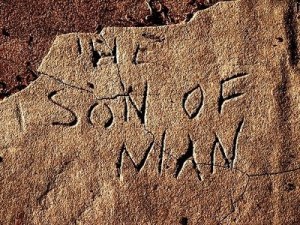In the Synoptic Gospels of Mark, Matthew, and Luke, Jesus is portrayed as considering himself the messiah, the future king of the Jews of the Messianic Age, but not as divine, or somehow equal to God. There are, however, descriptions of him able to access special favour with God, and that God would perform miracles and mighty deeds at his request. There is also mention of special abilities due to his intimacy with God.
Let's start with the Gospel of Mark.
MARK 1:
25 “Be quiet!” said Jesus sternly. “Come out of him!” 26 The impure spirit shook the man violently and came out of him with a shriek.
Jesus is shown as being able to cast out an impure spirit. This is not uncommon to reports of actions attributed to other Rabbis of the time.
32 That evening after sunset the people brought to Jesus all the sick and demon-possessed. 33 The whole town gathered at the door, 34 and Jesus healed many who had various diseases. He also drove out many demons, but he would not let the demons speak because they knew who he was.Jesus heals a number of people of various ailments throughout the book of Mark, this being an example. Again this is not uncommon in writings of the time about other Rabbis and the assumption is not that the individual themselves performed the healing, but their favour with God meant that God did the healing at their behest.
In fact, in the literature of the time, both Jewish and non-Jewish, is filled with healings and other miracles being attributed to important figures. This seems to be a common literary device to affirm the importance and validity of the figure being discussed. Pythagoras, the Greek mathematician and philosopher, was "documented" as having performed a series of miracles that rivals anything found in the Gospels.
MARK 2:
5 When Jesus saw their faith, he said to the paralyzed man, “Son, your sins are forgiven.” 6 Now some teachers of the law were sitting there, thinking to themselves, 7 “Why does this fellow talk like that? He’s blaspheming! Who can forgive sins but God alone?” 8 Immediately Jesus knew in his spirit that this was what they were thinking in their hearts, and he said to them, “Why are you thinking these things? 9 Which is easier: to say to this paralyzed man, ‘Your sins are forgiven,’ or to say, ‘Get up, take your mat and walk’? 10 But I want you to know that the Son of Man has authority on earth to forgive sins.”When Jesus tells the paralyzed man that his sins are forgiven, the teachers of the law respond that this is something only God can do. They are pretty much asking Jesus if he thinks he is God. Jesus here doesn't agree with them or claim Divinity. He talks about the "Son of Man" having authority on earth to forgive sins, not God, or the Son of God, the "Son of Man". What is somewhat confusing here and throughout the Gospels is that he always refers to this, "Son of Man", in the third person. Is he talking about himself, or someone else? Given the context, it would seem that he is talking about himself.
Question: "Why did you put that man in handcuffs?" Answer: "Because the police officer is given the authority to do that to people he arrests in this country." I don't think if someone answered a question in that manner that you would doubt that they were talking about themselves.
So, who is this, "Son of Man", and is he Divine?
The Hebrew expression "son of man" (בן–אדם, ben-'adam) appears 107 times in the Hebrew Bible, the majority (93 times) in the Book of Ezekiel.[1] It is used in three main ways: as a form of address (Ezekiel); to contrast the lowly status of humanity against the permanence and exulted dignity of God and the angels (Book of Numbers 23:19,Psalm 8:4); and as a future eschatological figure whose coming will signal the end of history and the time of God's judgement (Daniel 8:17).[2 ]https://en.m.wikipedia.org/wiki/Son_of_man#Old_Testament
The book of Ezekiel has God calling the Prophet Ezekiel, "son of man", ninety-three times. The Prophet Ezekiel was sent by God to speak to a people of Israel who God states to him would not be willing to listen because they were not willing to listen to God. So it would seem that Jesus' use of this title was primarily to "dis" those calling his words blasphemous, inferring that he spoke God's word and that the teachers of the law were not listening to him because they were not willing to listen to God. However, was it also meant to answer the question about whether only God could forgive sins?
He said to me, “Son of man, stand up on your feet and I will speak to you.” Ezekiel 2:1
Ezekiel was not considered Divine If this is the reference Jesus is making by calling himself the, "Son of Man", then perhaps he was claiming that special prophets called by God have the authority to forgive sins and that he fits this category.
The Prophet Ezekiel was not portrayed as having the authority to forgive sins in the Tanakh. In Ezekiel 33, however, God does tell the Prophet that those who turn away from their sin and do what is just and right will live and not die and that, "16 None of the sins that person has committed will be remembered against them." Might Jesus be referring to this? Could he be saying that because of his faith in Jesus' words and recognition that they, "came from God", that the paralyzed man had turned from sin to do what was just and right, and this meant that his sin was forgiven?
The other place in the Tanakh where the title, "Son of Man", was used was in the visions of Daniel, in the book of that name right after the book of Ezekiel.
13 “In my vision at night I looked, and there before me was one like a son of man,[a]coming with the clouds of heaven. He approached the Ancient of Days and was led into his presence. 14 He was given authority, glory and sovereign power; all nations and peoples of every language worshiped him. His dominion is an everlasting dominion that will not pass away, and his kingdom is one that will never be destroyed. (Daniel 7:13-14)
17 As he came near the place where I was standing, I was terrified and fell prostrate.“Son of man,”[b] he said to me, “understand that the vision concerns the time of the end.” (Daniel 8:17)The, "Son of Man", of Daniel is more likely the image Jesus was referencing, This figure, described as being, "like a son of man", is given, "authority, glory and sovereign power", as well as, "everlasting dominion". It would make sense for Jesus to claim that this authority included the forgiveness of sins on earth.
This Son of Man is obviously not God, but is he portrayed as, "more than human"? The figure in Daniel's vision is described as, "like", a son of man, literally in the Hebrew, "like", a, "human being". This might suggest that the figure, rather than being human, is angelic, one of the Heavenly Host. However, when looked at in the context of the vision and the interpretation of the images given in the vision, this appears not to be the case.
In Daniel's vision, he sees four beasts who are explained to represent four kings. They are portrayed as various beasts to describe the different qualities of baseness of each; terrifying, crushing and devouring humanity, their victims. These kings are given authority for a time to wreck havoc on mankind. They are given authority to rule for a period of time until God strips them of it and gives authority and everlasting dominion to the one like a human being. It would make sense that, just like the kings are human people envisioned as figures in the form of terrible beasts to describe their base natures, that the fifth king being foretold is also human and his representation, in contrast to the preceding kings, is being described as truly human in nature. It does not make sense to me that if the images of the first four kings are figurative representations of human people, that we would interpret the image of the fifth king as a literal description of a non-human being.
This is my take on the figure. But, what is important here is how the community and author of Mark perceived him and what they were trying to say about their perception of Jesus' own identity by using this title. What that view was I believe is telling in the fact that they had him use the title, "The Human Being", and not, "The One Like A Human Being".







